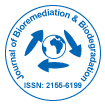Our Group organises 3000+ Global Conferenceseries Events every year across USA, Europe & Asia with support from 1000 more scientific Societies and Publishes 700+ Open Access Journals which contains over 50000 eminent personalities, reputed scientists as editorial board members.
Open Access Journals gaining more Readers and Citations
700 Journals and 15,000,000 Readers Each Journal is getting 25,000+ Readers
Google Scholar citation report
Citations : 7718
Journal of Bioremediation & Biodegradation received 7718 citations as per Google Scholar report
Journal of Bioremediation & Biodegradation peer review process verified at publons
Indexed In
- CAS Source Index (CASSI)
- Index Copernicus
- Google Scholar
- Sherpa Romeo
- Open J Gate
- Genamics JournalSeek
- Academic Keys
- JournalTOCs
- ResearchBible
- China National Knowledge Infrastructure (CNKI)
- Ulrich's Periodicals Directory
- Access to Global Online Research in Agriculture (AGORA)
- RefSeek
- Hamdard University
- EBSCO A-Z
- OCLC- WorldCat
- SWB online catalog
- Publons
- Geneva Foundation for Medical Education and Research
- MIAR
- ICMJE
Useful Links
Recommended Journals
Related Subjects
Share This Page
Clinical trial: Calcium alginate dressing incorporating nanoparticles in the treatment of diabetic neuropathic foot ulcers zinc oxide nanoparticles skin patches
3rd International Conference and Exhibition on Biopolymers & Bioplastics
A K Medina-Lira and R Betancourt-Galindo
Centro de Investigaci├?┬?├?┬│n en Qu├?┬?├?┬şmica Aplicada, M├?┬?├?┬ęxico
Posters & Accepted Abstracts: J Bioremed Biodeg
Abstract
Introduction: Diabetes Mellitus in developed countries have a prevalence of 11%. Diabetic foot is a complication of diabetes mellitus. The presence of diabetic foot ulcers varies between 4% and 10%. Foot infections are most common cause of hospitalization and often precede amputation. The indicated debridement in almost all ulcers is recommended to maintain a ├?┬ó├?┬?├?┬?moist wound healing├?┬ó├?┬?├?┬Ł, using the appropriate dressing. Aim: Aim of the study is to evaluate the effectiveness of a calcium alginate dressing with zinc oxide nanoparticles in the treatment of neuropathic diabetic foot ulcers. Materials & Methods: A prospective randomized controlled trial was conducted in 26 patients. The patients were randomized to two groups: group one (n=28) received treatment with calcium alginate dressings with nanoparticles, while the other group two (n=29) received the treatment (without nanoparticles). The dressing change was performed every 48 h. The duration of observations was at the interval of every 10 weeks. Results: After 10 weeks, healing was achieved in 24 (85.7% of n=28) patients in group one under treatment with calcium alginate nanoparticles versus 21 ( 72% of n=29) in the other group two (calcium alginate without nanoparticles) (p=0.03). The mean time to healing was 36 days├?┬?├?┬▒5 in the group one and 42 days├?┬?├?┬▒3.4 in group two (p=0.002), with significant differences between the two groups (p<0.028). Conclusion: Most patients included in both groups were not receiving proper treatment of the ulcer, the analysis of the results support the hypothesis that the use of calcium alginate dressings with nanoparticles induces a better tissue regeneration.Biography
Email: any_kaml@hotmail.com

 Spanish
Spanish  Chinese
Chinese  Russian
Russian  German
German  French
French  Japanese
Japanese  Portuguese
Portuguese  Hindi
Hindi 
